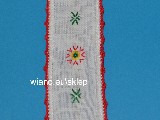Pobierz MP3
Festiwal Czango czytaj- Kujawiak od Bachorzy
Od Kujaw po Bałtyk czytaj - Starej babie młodego się zachciało
- Kolęda Hej w dzien narodzenia
Kolędy Podkarpacia czytaj - Piosenka dziecięca Sikoreczka pstra
Konkurs na pamiątkę czytaj
Partnerzy
Kontakt
2010-01-10 How to starch
Starching was used by our great-grandmothers for stiffening fabrics. Nowadays, this method is commonly used by housewives. Female folklore manufacturers who devote their time to crocheting and embroidering table napkins and tablecloths on a daily basis, have in this domain the greatest experience. They advise to give up on chemical preparations. They will not add any charm to the fabric, because they will not stiffen it as starching would.
Before starching, however, it is good to boil it, just the same way our grandmas used to. Of course, only under the condition that our material is suitable i.e. made from natural fabrics.
We put a pot with washing powder, napkins, tablecloths on the stove. We cook it for 10-15 minutes until all stains come off. ‘If the fabric is made of either flax or cotton it can be boiled. Even the embroidered ones are colour-fast’ the female folklore manufacturers assure us. ’Our products can be safely put in the pot.
After all, they do it themselves, as soon as the napkin has been crocheted and embroidered it is not ready yet to be sold to the customer. It is crumpled and slightly stained – the pattern of the embroidery is sketched on the fabric.
The starch is prepared the same way as kisiel (kind of fruit jelly served as dessert, popular in Poland). We boil approximately 0,5 liter of water. In a glass half-filled with water we put two spoonfuls of potato flour and carefully mix it. Next we pour the diluted flour into the boiling water and continuously stir it, until it becomes dense, then we remove it from the stove.
The napkins have to be dipped in a hot starch, then, when still wet, they should be immediately ironed or stretched on a forn or canvas and pinned, so that their natural form is preserved. This way they should be left until dry. Dry napkins will be stiff as cardboard.
The denser is starch, the stiffer are napkins. Depending on one’s needs the concentration of starch can be increased or decreased by adding water.
After an intense starching the napkins can become perfect mats for plates or cups, for instance in restaurants or cafes. One only needs to sprinkle them with hair spray in order to keep them clean. However, the effect of the starching itself protects the napkins from becoming dirty.
Female folklore manufacturers also advise to add a bit of salt to the starch, thanks to which, when ironing, the wet fabric does not stick to the iron. On the internet we have also located another advice, recommending to add a few spoonfuls of milk instead of salt (into the same amount of water).
Some recipes for starch:
1. Starch from potato flour
weak
1 teaspoonful of flour in 1 liter of water (bring to a boil)
Use: dresses, blouses, batiste, chiffon, tulle
medium
1 tablespoonful of flour in 1 liter of water (bring to a boil)
Use: tablecloth, napkins, slipcovers, bed linen
dense
1,5 tablespoonful of flour in 1 liter of water (bring to a boil)
Use: for stiffening collars and cuffs, for wet ironing
2. Starch from rice
Some recommend to use water (in which previously we boiled rice) for starch in the following proportions: 4 tablespoonfuls of rice in 2 liters of water
weak
4/5 of water for 1/5 of starch
Use: white linen, men’s shirts
medium
2/3 of water for 1/3 of starch
Use: napkins, bed linen
3. Starch from sugar
Sugar can be used for stiffening in the following proportions: 1 tablespoonful of sugar in 1 tablespoonful of water (bring to a boil)
Use: tulle, curtains (dip the dry needlework)
Starch can be prepared in a microwave.
1. Put 1/4 glass of flour in 1 glass of water and stir it carefully until the flour is diluted.
2. Prepare a container that can be placed in a microwave and pour 4 glasses of water into it and then the prepared mixture. Stir it so that it is thoroughly diluted.
3. Heat it in a microwave stirring it every 30 seconds, until it starts getting denser and boiling. At this point take it out and let it cool.
Artyku�y polecane
- Tłusty czwartek
dodano: 2012-02-15 | ( komentarzy: 0 ) - Ścinanie Śmierci
dodano: 2012-02-23 | ( komentarzy: 0 ) - Grupy zapustne
dodano: 2015-02-01 | ( komentarzy: 0 ) - Ceramika bolimowska
dodano: 2015-07-23 | ( komentarzy: 0 ) - Kujawskie zapusty
dodano: 2014-03-07 | ( komentarzy: 0 )
Najcz�ciej czytane
- Kwiaty z bibuły
dodano: 2013-01-07 | ( komentarzy: 0 ) - Kwiaty z bibuły
dodano: 2011-05-18 | ( komentarzy: 0 ) - Przepis na krochmal
dodano: 2010-01-10 | ( komentarzy: 3 ) - Jak zrobić beczkę
dodano: 2012-09-17 | ( komentarzy: 0 ) - Wieniec dożynkowy
dodano: 2012-07-29 | ( komentarzy: 0 )














Komentarze